
-
Find the right food for your petTake this quiz to see which food may be the best for your furry friend.Find the right food for your petTake this quiz to see which food may be the best for your furry friend.Featured products
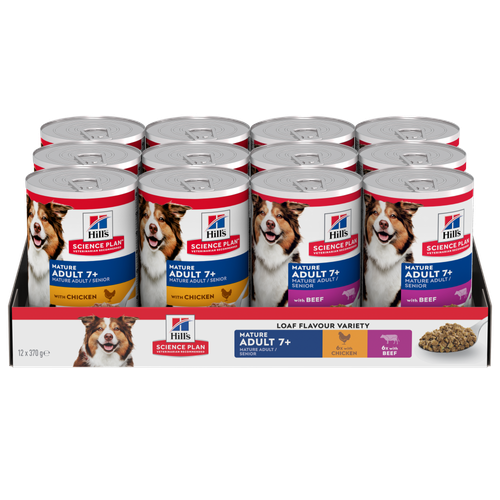 Mature Adult Dog Food
Mature Adult Dog FoodHill's Science Plan Mature Adult Multipack Wet Dog Food with Chicken & Beef are complete premium pet foods for mature adult dogs from 7 years. Your dog will love these deliciously smooth and savoury minced loaves, formulated to deliver the appropriate amount of energy to support the needs of adult dogs.
Shop Now Puppy Food
Puppy FoodHill's Science Plan Puppy Multipack Wet Dog Food with Chicken & Beef are complete premium pet foods for growing puppies from weaning until 1 year old and for pregnant and nursing dogs. Your puppy will love these deliciously smooth and savoury minced loaves, formulated for balanced nutrition and overall health.
Shop Now Adult Wet Dog Food with Beef
Adult Wet Dog Food with BeefHill's Science Plan Adult Multipack Wet Dog Food with Chicken, Beef & Turkey are complete premium pet foods for adult dogs from 1 year. Your dog will love these deliciously smooth and savoury minced loaves, formulated for balanced nutrition and overall health.
Shop NowFeatured products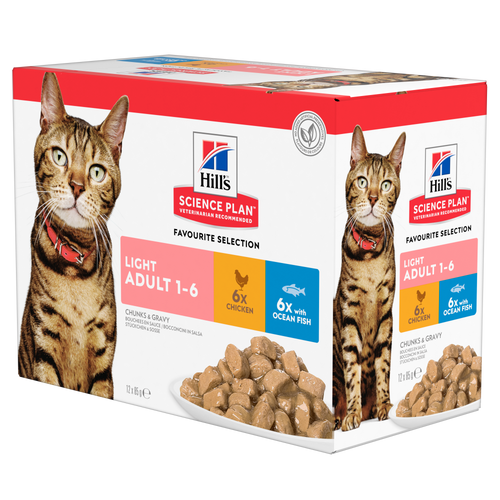 Light Adult Multipack Wet Cat Food with Chicken & Ocean Fish
Light Adult Multipack Wet Cat Food with Chicken & Ocean FishTender chicken chunks in gravy for cats, with L-carnitine and fewer calories for ideal weight management. Packed with high-quality protein, omega-6s, and vitamin E for shiny fur and healthy skin.
Shop Now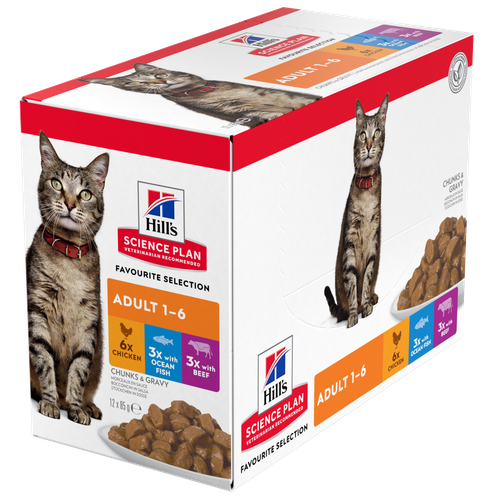 Adult Multipack Wet Cat Food with Beef, Ocean Fish & Chicken
Adult Multipack Wet Cat Food with Beef, Ocean Fish & ChickenTender chunks in gravy for cats, with high-quality protein to maintain lean muscle. With vitamin E and omega-3s & -6s for healthy skin and balanced minerals to support healthy vital organs.
Shop Now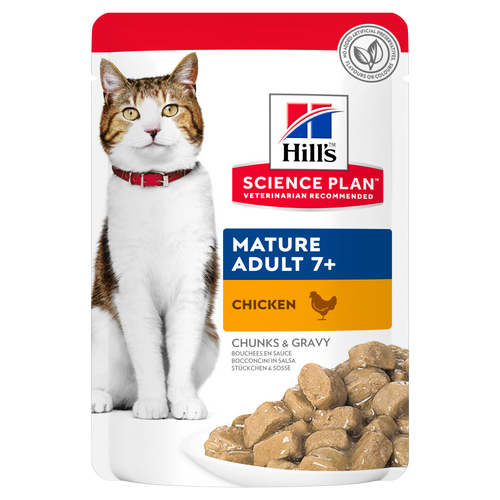 Mature Adult Wet Cat Food with Chicken
Mature Adult Wet Cat Food with Chicken
Tender chicken chunks in gravy for mature adult cats. Made with easy-to-digest ingredients, high-quality protein for lean muscle maintenance and antioxidant vitamins C+E for optimal health.
Shop Now -
Dog
- Dog Tips & Articles
-
Health Category
- Weight
- Food & Environmental Sensitivities
- Urinary
- Digestive
- Joint
- Kidney
-
Life Stage
- Puppy Nutrition
- Adult Nutrition
- Senior Nutrition
Cat- Cat Tips & Articles
-
Health Category
- Weight
- Skin & Food Sensitivities
- Urinary
- Digestive
- Kidney
-
Life Stage
- Kitten Nutrition
- Adult Nutrition
Featured articles The Right Diet For Your Pet
The Right Diet For Your PetIn people, the right diet is very important. If you are eating the wrong way for your metabolism, activity level, age and lifestyle you could end up with health issues.
Read More The Incredible Science Behind Your Pet's Microbiome
The Incredible Science Behind Your Pet's MicrobiomeLearn what your pet's microbiome is, how it contributes to your pet's gut and overall health, and why nutrition is important in maintaining healthy microbiomes.
Read More Show some love with wet foods: a great choice for pets with health issues
Show some love with wet foods: a great choice for pets with health issuesShow some love with wet foods: a great choice for pets with health issues.
Read More -


Although it's common to hear stories of dogs getting sick from chocolate ingestion, chocolate can also pose a serious health risk to cats, even becoming fatal if too much is eaten.
Why Is Chocolate Bad for Cats?
Sugar, fat, and xylitol (a sugar substitute) aren't good for cats. However, chocolate contains two ingredients that pose a bigger threat to your cat’s health: caffeine and theobromine, a plant alkaloid that occurs naturally in cacao. Theobromine in particular is a proven toxin for most animals, including cats, as noted by the Merck MSD Veterinary Manual.
The Latin name for the cocoa plant is Theobroma cacao, meaning "food for the gods". It’s true that the roasted beans do make a yummy treat, but what makes chocolate so delightful for humans is exactly what makes it so dangerous for cats.
Why Are These Ingredients so Dangerous for Cats?

The two main culprits, caffeine and theobromine, are stimulants. Caffeine, found in many food and drink items besides chocolate, becomes toxic when absorbed into your cat's body. Cats Protection explains that theobromine acts as a stimulant to increase your cat’s heart rate, and as a diuretic to increase the loss of bodily fluids, both of which can prove fatal for your furry friend.
How Much Chocolate Is Too Much?
Any amount of chocolate is too much for your cat. Cats Protection explains that cats can’t process theobromine as quickly as we can so it stays in the body for longer. That means that even a couple of grams of chocolate can cause serious harm.
All forms of chocolate are hazardous to your furry friend. Baking chocolate is most toxic due to its high level of theobromine, but dry cocoa powder and dark, semi-sweet, and milk chocolate are also dangerous. Even white chocolate, with its low percentage of cocoa, should be avoided.


Tasty Tips
Help — My Cat Ate Chocolate! What Symptoms Should I Watch For?
Chocolate toxicity in cats can range from mild to severe. Here are some of the main signs and symptoms to look out for:
- Vomiting
- Diarrhoea
- Nausea
- Increased heart rate
- Excessive thirst
- Excessive urination
- Hyperactivity
- Restlessness
- Increased body temperature
- Rapid breathing or panting
- Muscle tremors or twitching
- Low blood pressure
- Seizures
- Coma
As you would with any medical emergency, immediately bring your cat to the vet to determine the extent of the poisoning and to receive treatment. After treatment, continue to monitor your cat for any other ill effects.
What Happens Next?
Your cat is very in-tune with your emotions so remain as calm as possible. Take them to a quiet place and keep them cool and calm to prevent the symptoms of chocolate poisoning from escalating.
Once you arrive at the vet clinic, the veterinarian will examine your cat and assess the amount and type of chocolate your cat has eaten. The vet may want to induce vomiting to help prevent your cat from absorbing the toxins, and will provide fluids and additional care depending on the amount of chocolate consumed and the side effects your cat is experiencing.
How Do I Prevent This from Happening?
Chocolate ingestion is 100% preventable by keeping chocolate out of paw's reach. Cats are curious, unpredictable creatures and love to snoop around the kitchen, so secure all chocolate in a tightly sealed container. It's not just chocolate bars that can make them sick, so think of all the things that might contain chocolate, including brownies, doughnuts, biscuits and sweets. This is especially true around holidays like Easter, Christmas and Halloween. If you're entertaining, place sweet dishes, desserts and treats in places that are difficult for your cat to reach and store them securely immediately after the party. If a guest asks, "can your cat eat chocolate?", you are now prepared to answer with a resounding "no".
Pet parents do like to treat their feline friends, and you can do so safely by sticking to safe cat treats, created to keep your cat happy and healthy. Then you get to keep the chocolate all to yourself!


Christine O'Brien is a writer, mom, and long-time cat parent whose two Russian Blues rule the house. Her work also appears in Care.com, What to Expect, and Fit Pregnancy, where she writes about pets, pregnancy, and family life. Find and follow her on Instagram and Twitter @brovelliobrien.
Related products
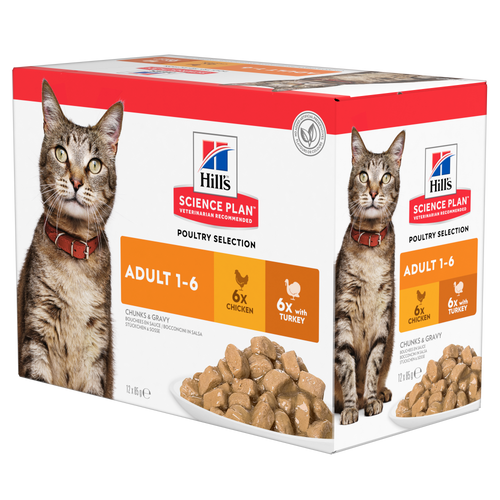

Tender chicken chunks in gravy for cats, with L-carnitine and fewer calories for ideal weight management. Packed with high-quality protein, omega-6s, and vitamin E for shiny fur and healthy skin.

Tender chunks in gravy for cats, with high-quality protein to maintain lean muscle. With vitamin E and omega-3s & -6s for healthy skin and balanced minerals to support healthy vital organs.

Tender chicken chunks in gravy for mature adult cats. Made with easy-to-digest ingredients, high-quality protein for lean muscle maintenance and antioxidant vitamins C+E for optimal health.
Related articles

There are three common ways to feed a cat. Each way has its advantages and disadvantages.

From essential vitamins & minerals to different types of meat, learn what to look for when choosing the best cat food for your feline.

Learn how to make homemade cat treats that are healthy for your pet with this recipe from Hills Pet Nutrition.

Kittens grow a lot in their first year, so it is important to provide them with the proper nutrients early, so they grow up healthy and strong. Learn more.

Put your cat on a diet without them knowing
Our low calorie formula helps you control your cat's weight. It's packed with high-quality protein for building lean muscles, and made with purposeful ingredients for a flavourful, nutritious meal. Clinically proven antioxidants, Vitamin C+E, help promote a healthy immune system.
Put your cat on a diet without them knowing
Our low calorie formula helps you control your cat's weight. It's packed with high-quality protein for building lean muscles, and made with purposeful ingredients for a flavourful, nutritious meal. Clinically proven antioxidants, Vitamin C+E, help promote a healthy immune system.

